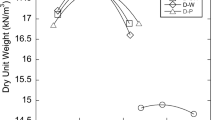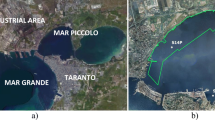Abstract
Mechanical stabilization methods for improving chemical stability of contaminated dredged material used for upland disposal are presented. Assessments of long term environmental consequences involving effects on heavy metal immobilization, TOC, COD, BOD, anion release, gas production and -composition after addition of lime, calcium carbonate, cement, coal fly ash and gypsum to fine grained Hamburg harbour sediments have been studied. Best results are attained with CaC03 due to insitu pH conditions and sufficient buffer capacity, which is of prime importance for metal immobilization and gas production.
Access this chapter
Tax calculation will be finalised at checkout
Purchases are for personal use only
Preview
Unable to display preview. Download preview PDF.
Similar content being viewed by others
References
Van Driel W., Kerdijk H.N. and Salomons W.: Use and disposal of contaminated dredged material. Land Water International 53, 13–18, 1984.
Windom H.L.: Environmental aspects of dredging in the coastal zone. CRC Critical Reviews Environmental Control 5, 91–109, 1976.
d’Angremond K., Brakel J., Hoekstra A.J., Kleinbloesem W.C. H., Nederlof L. and De Nekker J.: Assessment of Certain European Dredging Practices and Dredged Material Containment and Reclamation Methods. DMRP-Report D-78-58: US Army Corps of Engineers Waterways Experiment Station, Vicksburg, 1978.
Gambrell R.P., Khalid R.A., Patrick W.H.jr.: Disposal Alternatives for Contaminated Dredged Material as a Management Tool to Minimize Environmental Effects. DMRP-Report DS-78-8: US Army Corps of Engineers Waterways Experiment Station, Vicksburg, Miss, 1978.
Rulkens W.H., Assink J.W. and Van Gemert W.J.Th.: On-site Processing of Contaminated Soil. Project B. NATO/CCMS Study on Contaminated Land. 3rd Draft, Sept. 1983 (unpublished).
Barnes D., Fitzgerald P. and McFarland R.: Matrix effects in the chemical fixation of copper, lead and zinc bearing wastes. Proc. Int. Conf. Heavy Metals in the Environment, Athens 1985. Edinburgh: CEP Consultants Ltd., p. 585–588, 1985.
Smith I.C.: Control of Mercury in Sediments. USEPA Report EPA-R2-72-053, 53 pp., 1972.
Jernelöv A. and Lann H.: Studies in Sweden on feasibility of some methods for restoration of mercury contaminated bodies of water. Environ. Sci. Technol. 7, 712–718, 1973.
Reimers R.S., Krenkel P.A., Eagle M. and Tragift G.: Sorption phenomenon in the organics of bottom sediments. In: Krenkel P.A.(ed.): Heavy Metals in the Aquatic Environment. Oxford: Pergamon Press, p. 117–136, 1975.
Wolery T.J. and Walters L.J.jr.: Pollutant mercury and sedimentation in the western basin of Lake Erie. Proc. 17th Conf. Great Lakes Res., Intern. Assoc. Great Lakes Res., p. 235–149, 1974.
US Environment Protection Agency: Hazardous Waste Management System and Consolidated Permit Regulations. Federal Register Vol. 45, No. 98, Book 2, 1980.
Lee G.F. and Plumb R.H.: Literature Review on Research Study for the Development of Dredged Material Disposal Criteria. DMRP-Report D-74-1: US Army Corps of Engineers Waterways Experiment Station, Vicksburg, Miss., 1974.
Lee G.F., Lopez J.M. and Piwoni M.D.: Evaluation of the Factors Influencing the Results of the Elutriate Test for Dredged Material Disposal Criteria. In: Krenkel P.A. et al. (eds.): Dredging and Its Environmental Effects. New York: American Soc. of Civil Engineers, p. 253–288, 1976.
Kersten M. and Förstner U.: Chemical fractionation of heavy metals in anoxic estuarine and coastal sediments. Wat. Sci. Technol., 1986 (in press).
Fagerström T. and Jerneldv A.: Aspects of the quantitative ecology of mercury. Water Res. 6, 1193–1202, 1972.
Singer P.C. and Stumm W.: Acidic mine drainage: The rate- determining step. Science 167, 1121–1123, 1970.
Calmano W., Ahlf W. and Forstner U.: Heavy metal removal from contaminated sludges with dissolved sulfur dioxide in combination with bacterial leaching. Proc. Intern. Conf. Heavy Metals in the Environment, Heidelberg 1983. Edinburgh: CEP Consultants Ltd, p. 952–955, 1983.
Förstner U., Ahlf W., Calmano W., Kersten M. and Salomons W. Mobility of heavy metals in dredged harbor sediments. In: Sly P.G.(ed.): Proc. 3rd Symp. Sediment and Water Interactions, Geneva 1984. New York:Springer,1985 (in press)
Theis T.L. and Padgett L.E.: Factors affecting the release of trace metals from municipal sludge ashes. J. Water Pollut. Control Fed. 55, 1271–1279, 1983.
Gambrell R.P., Reddy C.N. and Khalid R.A.: Characterization of trace and toxic materials in sediments of a lake being restored. J. Water Pollut. Control Fed. 55, 1201–1213, 1983.
Brannon J.M., Engler R.M., Rose J.R., Hunt P.G. and Smith I. Distribution of toxic heavy metals in marine and freshwater sediments. In: Krenkel P.A. et al.(eds.): Dredging and Its Environmental Effects. New York: American Soc. of Civil Engineers, p. 455–495, 1976.
Calmano W. and Forstner U.: Chemical extraction of heavy metals in polluted river sediments in Central Europe. Sci. Total Environ. 28, 77–90, 1983.
Tessier A., Campbell P.G.C. and Bisson M.: Sequential extraction procedure for the speciation of trace metals in particulates. Anal. Chem. 51, 844–851, 1979.
Lee C.R., Peddicord R.K., Palermo M.R. and Francingues N.R.: A management Strategy for Dredged Material Disposal that Incorporates Test Methods Simulating Disposal Environments. US Army Corps of Engineers Waterways Experiment Station, Report MP-EL-85, Vickburg, MS, 1985 (in press).
Fachgruppe Wasserchemie in der GdCh.: Deutsche Einheits- verfahren zur Wasser-, Abwasser- und Schlammuntersuchung. Weinheim: Verlag Chemie, 12. Lfg., 1983.
Kester D.R., Ketchum B.H., Duedall I.W. and Park P.K. (eds.): Wastes in the Ocean. Vol. 2: Dredged-Material Disposal in the Ocean. New York: Wiley, 299 pp., 1983.
Editor information
Editors and Affiliations
Rights and permissions
Copyright information
© 1986 Martinus Nijhoff Publisher, Dordrecht
About this chapter
Cite this chapter
Calmano, W., Förstner, U., Kersten, M., Krause, D. (1986). Behaviour of Dredged Mud after Stabilization with Different Additives. In: Assink, J.W., Van Den Brink, W.J. (eds) Contaminated Soil. Springer, Dordrecht. https://doi.org/10.1007/978-94-009-5181-5_83
Download citation
DOI: https://doi.org/10.1007/978-94-009-5181-5_83
Publisher Name: Springer, Dordrecht
Print ISBN: 978-94-010-8793-3
Online ISBN: 978-94-009-5181-5
eBook Packages: Springer Book Archive




